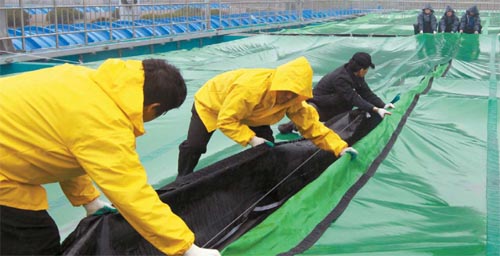Radioactive rain fear overblown

Workers at a water purification plant in Hanam, east of Seoul, cover a reservoir with vinyl as rain containing radioactive materials from the crippled Japanese nuclear plant in Fukushima panicked people across Korea. But only miniscule traces of radioactivity were detected. [YONHAP]
Korea braced itself against rain contaminated with radioactive fallout from Japan’s stricken Fukushima Daiichi nuclear plant, covering tap water storage facilities and giving kids a radiation day holiday from school.
But the fear of contamination was far more prevalent than actual radiation, which came in miniscule quantities.
“I was driving my daughter to school,” said a Seoul parent surnamed Lee, “and one drop of rain fell on her lip from the open window. She said she felt a blister coming on.”
In fact, the first region expected to be hit by radiation, Jeju Island, had negligible amounts of radiation Wednesday, and it didn’t even come from Japan.
“The Korea Institute of Nuclear Safety, knowing that Jeju Island would be first to be hit with radiation, has been conducting screenings of the air every three hours,” said Youn Choul-ho, head of KINS during a press briefing yesterday. “Rain that fell was also screened and the results have told us that the radiation levels are ignorable, though miniscule amounts of radioactive iodine and cesium were found.” The radiation may have come from China.
“It is difficult for the air over Fukushima to directly transfer to the Korean Peninsula,” said Kim Seung-bae, spokesman for the Korea Meteorological Administration.
The KMA said in a briefing yesterday that radiation levels in the rain were “not harmful to the human body” and advised schools not to take measures that were “too drastic.”
But in Gyeonggi, where school principals have the power to cancel classes, 126 schools told their students to stay home yesterday, according to the Gyeonggi Education Office.
Education offices around the country advised schools to refrain from conducting outdoor activities. Streets in front of schools were jammed with cars because parents drove their children to school rather than letting them walk in the rain.
According to Park Cheng-ho of KINS, miniscule levels of radiation were detected in rain in 11 of the country’s 12 screening regions. (In the 12th region, Northern Gangneung, it didn’t rain.) KINS won’t announce the radiation levels until this morning at 10:00 a.m.
“There are places where [radiation levels] have increased and others where it decreased,” said KINS chief Youn. “We cannot come to a clear conclusion just by looking at the areas where radiation levels have grown. It’s difficult to find a pattern nationwide when the levels found have been so miniscule.”
The Ministry of Environment gave out orders to Seoul officials to “take proper care” of water service pipes and storage facilities. The ministry also ordered filtration tanks that are open to the air to be covered, which Seoul officials have said is “impossible.”
According to a Seoul official, to protect the public’s drinking water, the entire Han River, its main source, would have to be covered.
The first task force meeting of related government bureau officials was held yesterday in Seoul to set up communication lines between bureaus in the case of nuclear emergencies.
And Japan offered an apologetic response on Wednesday regarding the Korean government’s protest that it wasn’t warned in advance of the plan to dump tens of thousands of tons of radioactive water from the Fukushima plant into the Pacific Ocean.
According to a Korean government official, though the Japanese government expressed regret, it was clearly shirking its responsibility, as Japan and Korea signed an agreement in 1990 regarding nuclear safety. The agreement requires each country to inform the other immediately in the case of nuclear emergencies.
In 2008, the Korean government wanted a three-way agreement with Japan and China on the development of emergency communication lines in the case of nuclear reactor accidents in any of the three countries. The idea was not supported by Japan and China.
By Christine Kim [christine.kim@joongang.co.kr]
한글 관련 기사 [경향신문]
방사능 비…전국이 ‘불안’에 젖다
제주 빗물 요오드·세슘 검출
당국 “인체 유해수준 아니다”
7일 전국적으로 ‘방사능 비’가 내렸다. 정부는 검출된 방사성물질이 극미량이어서 인체에 해가 없는 수준이라고 밝혔지만, 시민들은 불안감을 감추지 못했다.
정부는 노천 정수장에 덮개를 설치하라고 긴급 지시하는 등 ‘뒷북’ 대책을 내놓아 혼란을 가중시켰다.
한국원자력안전기술원에 따르면 제주지역에는 지난 6일 오후 8시20분부터 7일 오전 3시까지 내린 비에서 방사성 요오드131과 방사성 세슘137, 134가 각각 최대 2.77베크렐(㏃)/ℓ, 0.988㏃/ℓ, 1.01㏃/ℓ 검출됐다. 이는 일반인 방사선량 한도의 약 20분의 1~110분의 1 수준이다.
공기 중 방사성 요오드와 세슘의 양은 계속 늘고 있다. 원자력안전기술원이 지난 5~6일 채집한 대기 중 부유먼지에서 방사성물질을 검사한 결과 전국 12개 측정소에서 방사성 요오드와 세슘이 검출됐다. 12곳 모두에서 세슘이 발견된 것은 처음이다. 군산의 방사성 요오드 양은 3.12밀리베크렐(m㏃)/㎥로 후쿠시마 원전 폭발 뒤 가장 높은 수치를 기록했다.
윤철호 원자력안전기술원장은 “(해외 기관이) 일본에서 우리나라로 방사성물질이 직접 유입될 수 있다고 예상한 시간대에, 제주에서 오히려 방사성물질이 줄거나 검출되지 않았다”며 “따라서 남쪽으로부터 기류가 직접 유입됐다고 보기는 어렵다”고 밝혔다.
이날 전국 곳곳에서 비가 내리자 출퇴근길은 우비와 우산으로 넘쳤고, 경기·전북 지역 등에서는 상당수 학교가 휴업했다. 환경부는 비가 내리기 직전인 6일 오후에야 노천 정수장에 빗물 방지용 덮개를 씌우라는 지침을 각 시·도에 내려보냈다.
7일 오후 11시 현재 서울의 강수량은 7㎜를 나타냈으며 경남 창원 48.5㎜, 전남 완도 52.5㎜ 등 남부지방에 많은 비가 내렸다. 기상청은 8일 비가 그치면서 일부 지역에 황사가 나타날 것으로 예상했다.










with the Korea JoongAng Daily
To write comments, please log in to one of the accounts.
Standards Board Policy (0/250자)